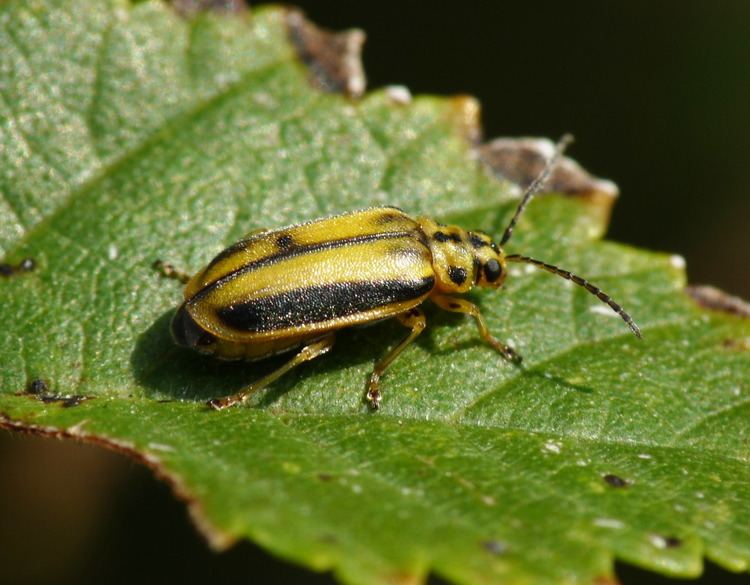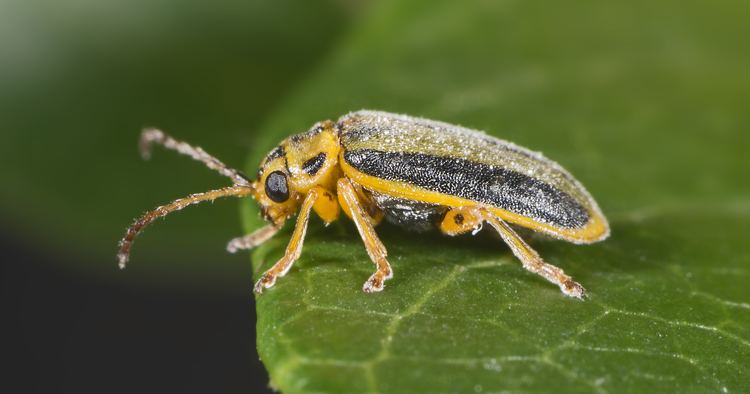Order Coleoptera Higher classification Xanthogaleruca | Family Chrysomelidae Scientific name Xanthogaleruca luteola Rank Species | |
 | ||
Similar Hemlock, Winter moth, Beetle, Emerald ash borer, Elm | ||
Elm leaf beetle controlling this damaging pest in denver and along the front range
Xanthogaleruca luteola, commonly known as the elm-leaf beetle, is an invasive beetle pest species in the family Chrysomelidae.
Contents
- Elm leaf beetle controlling this damaging pest in denver and along the front range
- Description
- Distribution
- Ecology
- Symptoms
- Controls
- References
Description

The imago (adult beetle) is 6–8 mm in length, ranges from yellow to green in colour, with a spot on its head, an hourglass mark and two spots on the pronotum, and a broad, dark stripe along the edge of each elytron. The larvae are usually black, occasionally black and yellow, with multiple rows of dots on the back and on the sides and < 13 mm long. The pupae are orange-yellow with black chaetae. The ova are yellow, and laid in spindle-like clusters of < 25 on the undersides of the elm leaves.
Distribution
These beetles are common in the Western Palaearctic ecozone from Portugal to Central Asia. Indigenous to Europe, it was accidentally introduced to North America and Australia. It is now widespread, and a serious pest in Australia and parts of North America.
Ecology

Xanthogaleruca luteola is a serious pest of the elm. Both the adults and larvae feed on the emergent leaves of the elm. Repeated heavy infestation rarely kills the tree outright but weakens it, rendering it vulnerable to disease. Falling branches encourage elm bark beetles to proliferate; the beetles are vectors of Dutch elm disease. However, elm leaf beetles do not transmit the disease.

Elm leaf beetles become active in the spring once temperatures rise above 52 °F (11 °C). In fact, weather is one of the most limiting factors in the population growth of Xanthogaleruca luteola. A late spring freeze or long winter can kill off entire elm leaf beetle colonies. The imagines depart their hibernation sites (often houses), the females laying their ova on the underside of the elm leaves. The ova hatch after one week, the larvae immediately feed on the underside of the leaves. This larval stage lasts for a period of between two and three weeks, at the end of which it will migrate to the lower part of the tree in search of bark crevices in which to pupate. The next generation emerges in mid-summer after two to three weeks' pupation, and begins feeding on the leaves. The female can lay < 800 ova, but this ovipositing may be interrupted by shortening of the photoperiod to < 14 hours, inducing a brief feeding bout before the search for a hibernation site.
Hosts are known to include English Elm (U. minor 'Atinia'), Wych (Scots) Elm (Ulmus glabra), American Elm (Ulmus americana), Siberian Elm (Ulmus pumila), Chinese Elm (Ulmus parvifolia) as well as complex hybrids such as 'Homestead'. The beetle has also been reported on Zelkova serrata.
Symptoms
The first and most apparent symptoms are of skeletonization. During feeding, elm leaf beetle larvae skeletonize the tree. They leave the upper tree and veins intact, which gives the foliage a net-like appearance. Areas around the feeding site will dry up and die, causing the leaf to drop prematurely. Adults, on the other hand, will chew small, irregularly shaped holes in the expanding leaves. Trees that lose their leaves often develop a second set, only to have them consumed when the next generation is produced.
Controls
In North America, there are few natural enemies, but in Europe, the ova of the beetle are often heavily predated by the chalcidoid wasp Oomyzus gallerucae. Insecticide sprays are of little use since by the time the infestation is apparent, the application will be too late to be effective. However, tree trunks banded with insecticides can limit repetition the following year by killing the larvae as they descend before hibernation. Soil injection presents a non-invasive alternative to trunk injections with a 2-year effect on the X. luteola population.
Since overwintering elm leaf beetles infest the homes of those close to an elm leaf beetle infestation, it is suggested that all cracks outside the house should be sealed. It is discouraged to use insecticides unless there are really heavy colonies.
Nearly all chemicals currently used commercially in Australia to treat Elm Leaf Beetle, regardless of brand name or delivery method, are neonicotinoid insecticides. This is the chemical type that has had (2016) a two-year ban placed on it by the European Commission, owing to the association between the widespread use of these chemicals and their impact on bee populations.
